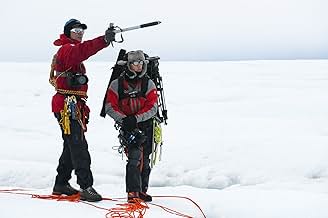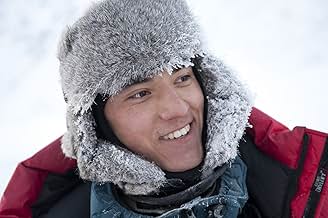Acompanha James Balog, fotógrafo da National Geographic, pelo Ártico enquanto ele instala câmeras de lapso de tempo projetadas com um propósito: capturar um registro de longo prazo das mudan... Ler tudoAcompanha James Balog, fotógrafo da National Geographic, pelo Ártico enquanto ele instala câmeras de lapso de tempo projetadas com um propósito: capturar um registro de longo prazo das mudanças nas geleiras do mundo.Acompanha James Balog, fotógrafo da National Geographic, pelo Ártico enquanto ele instala câmeras de lapso de tempo projetadas com um propósito: capturar um registro de longo prazo das mudanças nas geleiras do mundo.
- Indicado a 1 Oscar
- 9 vitórias e 5 indicações no total
- Self - National Geographic Explorer
- (as Sylvia Earle Ph.D.)
- Self - EIS Engineer
- (as Adam Lewinter)
- Self - Climatologist, Ohio State University
- (as Jason Box Ph.D.)
- Self - Glaciologist, University of Colorado
- (as Tad Pfeffer Ph.D.)
- Self - EIS Videographer
- (as Jeff Orlowski)
- Self - Oceanographer, National Center for Atmospheric Research
- (as Synte Peacock Ph.D.)
- Self - Senior Fellow, Stanford University Woods Institute
- (as Terry Root Ph.D.)
- Self - Directof of Tree-Ring Research, University of Arizona
- (as Thomas Swetnam Ph.D.)
- Self - Head of Geo Risks Research, Munich Reinsurance
- (as Peter Hoeppe Ph.D.)
- Self - Senior Scientist, National Center for Atmospheric Research
- (as Gerald Meehl Ph.D.)
Avaliações em destaque
Instead they spend way too much telling their own story. They delve into the technical difficulties of mounting cameras to photograph distant glaciers over a period of years, the complexities of hiking to these locations, the personal danger and discomfort they had to endure, and most peculiarly the physical problems that lead photographer James Balog experienced with his knee problems and surgeries. All these personal stories are interesting to a point, but distract from scientific case that they need to make. This should be a scientific and environmental story not a personal narrative. The powerful case that the beautiful photography makes is undermined, by poorly conceived film narrative. The average viewer needs a lot better understanding of what the melting of the glaciers means and what sort of affect this will have on their daily life in the near future. A better narrative device might have been to show the melting ice of the glaciers and then film the rising sea level in other parts of the world. Some reports have suggested that the Maldives Islands might soon be underwater. Showing where the water from the melting glaciers is ending up could have proved to be a much more powerful narrative device. I wish they had done a better job at telling an important scientific story with deep political and moral significance for the planet.
During the Q&A after the film, Balog argued that this isn't a political problem, that it is a universal problem. It may be a universal problem, but its solution requires collective political action that is based on science not emotion. They are naive if they are unwilling to engage the powerful political debate that is preventing progress on this issue.
What this documentary does is capture his journey to photograph these glaciers. It shows his struggles, his failures, and his successes. Yes, he may come off as a bit of a hero, but what he's doing truly is heroic and simply cannot be missed. The photography throughout this film is spectacular--absolutely gorgeous. In fact, he photographed an article on this topic for National Geographic, and if you've seen their photographs, you know the level of quality we're talking about here.
At the same time, however, there's kind of this sense of impending doom amidst all the beauty. It essentially shows all the damage humanity has done, in the past ten or so years alone, and I can only hope it's not too late to fix at least some of what we've caused. If this documentary can't get you to see the world and it's people differently, then I don't think much else can, his results are simply that stunning.
The documentary follows National Geographic photographer and Extreme Ice Survey founder James Balog and his passionate team across Greenland, Iceland, Alaska and the Arctic as they installs custom-made time-lapse cameras to document never before seen glaciation at an extreme. The resulting photography is both frightening and breathtakingly beautiful.
The issues that many people seem to have with this film are that it doesn't engage in a political argument and that it doesn't provide a solution to the problem. Balog stated that this isn't a political problem, it's a universal problem. The point is he's delivering a message with his photography and he's letting the photographs do the talking, not tarnishing the message with politics. & the aim of this film is to spread awareness not to provide a solution.
This is an eye-opener and a visual reference as to how much climate change is immediately effecting our plant. At one point we witness footage of the largest ever recorded glacier calving, an iceberg larger than the island of Manhattan calves from a glacier in about 75 minutes. Politicians and energy corporation executives should be made sit a mandatory viewing of this. Seize any opportunity you get to go see this on the big screen.
You can now apply to host a screening on the Chasing Ice website!
The footage is magnificent and the film is scored very well. James Balog's personal challenges in undertaking the project are also documented, and present an interesting angle to this style of documentary.
By presenting the footage in as non-partisan manner as possible, Chasing Ice avoids tarnishing its message with politics.
Você sabia?
- CuriosidadesHolds the record for containing the biggest and longest lasting glacier calving that has ever been put to film. On May 28th, 2008, the Jakobshawn Glacier in Greenland had a calving event that lasted 75 straight minutes. It resulted in 7.4 Cubic KB of ice crashing into the ocean.
- Citações
James Balog - Photographer: If you had an abscess in your tooth, would you keep going to dentist after dentist until you found a dentist who said, "Ah, don't worry about it. Leave that rotten tooth in"? Or would you pull it out because more of the other dentists told you you had a problem? That's sort of what we're doing with climate change.
- ConexõesFeatured in Moyers & Company: Justice, Not Politics (2012)
- Trilhas sonorasBefore My Time
Music and Lyrics by J. Ralph
Produced, Arranged, Engineered and Mixed by J. Ralph
Co-produced and Engineered by Arthur Pingrey
Protools by Arthur Pingrey
Performed by Scarlett Johansson and Joshua Bell
Piano by Jay Israelson
Mastered by Bob Ludwig at Gateway Mastering
Legal by Alan Kress
Recorded at The Theater, New York City, January 2012 and March 2012
Special Thanks to Danny Bensi, Camilla Olson, Heidi Frederick and Alan Kress
Joshua Bell appears courtesy of Sony Classical
Principais escolhas
- How long is Chasing Ice?Fornecido pela Alexa
Detalhes
Bilheteria
- Faturamento bruto nos EUA e Canadá
- US$ 1.328.467
- Faturamento bruto mundial
- US$ 1.358.668
- Tempo de duração1 hora 15 minutos
- Cor
Contribua para esta página





























